What do New Hampshire voters think about the affordable housing crisis? Since 2020, Saint Anselm College has administered an annual statewide poll of voter attitudes on affordable housing. The most recent poll shows that pro-housing attitudes remain consistently strong across all demographic categories, and that there is growing support for state effort in solving the affordable housing shortage.
Support for pro-housing positions was widespread across all subpopulations, with notably strong support from homeowners and New Hampshire seniors (age 65+)--two subcategories that are often assumed to be NIMBY (Not-In-My-Backyard) and resistant to change.
Two new questions in the 2024 survey tested voter attitudes on local control as well as on increased state funding for affordable housing. On both topics respondents signaled support for state action.
For specific results and changes from 2023, see the results of each question below.
The poll was conducted by the Saint Anselm College Survey Center from June 12-18, 2024. 844 registered New Hampshire voters were surveyed, with a margin of sampling error of +/-3.4% and a confidence interval of 95%.
75% of New Hampshire voters think that their communities need more affordable housing to be built.
Our survey results show that pro-housing attitudes remain consistently strong across all demographic categories. 75% of survey respondents agreed with the statement “My community needs more affordable housing to be built.” (In 2023, 78% of respondents were in agreement.)
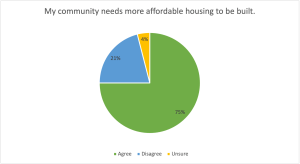
59% of New Hampshire voters now want more affordable homes in their own neighborhoods.
New Hampshire is seeing a decline in NIMBYISM (not-in-my-backyard sentiment). More and more residents are recognizing the need for more affordable homes not just in the state and their communities, but even in their own neighborhoods. 59% agreed with the statement, “My neighborhood needs more affordable housing to built.” (In 2023, 58% were in agreement.)
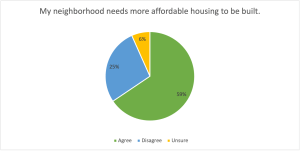
61% of Granite Staters think that our towns and cities should change land use regulations in order to allow more housing to be built.
In keeping with the bump registered in last year’s survey, 61% of respondents expressed a desire for their towns and communities to loosen zoning restrictions. This signals a perception that restrictive zoning is limiting housing supply.
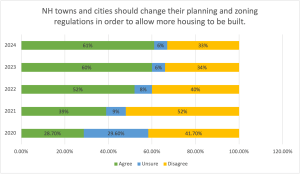
A majority of people in New Hampshire are against doing more to prevent housing development and keeping the state the way it is.
The annual survey mixes in some anti-housing statements, and each year the numbers agreeing with these statements declines. Net agreement with the statement, “New Hampshire should do more to prevent housing development and keep the state the way it is”: from -11 net agreement to -24 (35% agreeing and 59% disagreeing with this anti-housing statement).
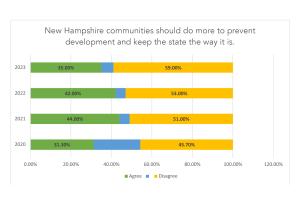
63% of NH voters think that the state should do more to encourage municipalities to remove barriers to housing development.
Polling shows there is growing skepticism about local control from NH voters. As indicated by the last polling question, voters want planning and regulation changes in their communities, but don’t seem to really care whether communities make those changes on their own, or if the state nudges their communities to do so. Of those responding to the poll, 63% agreed that the state should do more to encourage municipalities to remove barriers to housing development.
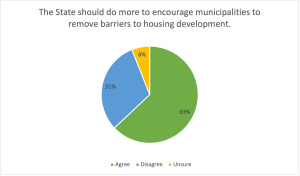
57% of homeowners support more housing in their neighborhood.
The recent poll also shows a decline in NIMBY (“not in my backyard”) attitudes among homeowners. In recent years, while both renters and homeowners have shown strong support for pro-housing measures in their own neighborhoods, renters have generally been more favorable. This year’s polling shows that the gap is narrowing, with homeowner support for more housing in their neighborhoods rising from +10 in 2023 to +20 in 2024, with 57% in favor and 37% opposed.
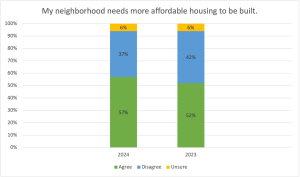
A majority of people in New Hampshire are against doing more to prevent housing development and keeping the state the way it is.
The Center’s annual survey mixes in some anti-housing statements, and each year the numbers agreeing with these statements declines. Net disagreement from with the statement, “New Hampshire should do more to prevent housing development and keep the state the way it is” rose from -24 in 2023 to -27 in 2024 (35% agreeing and 62% disagreeing with this anti-housing statement).
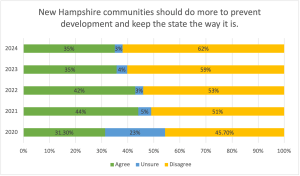
New Hampshire residents 65 or older overwhelmingly support more affordable housing in their communities.
While every age group expressed pro-housing attitudes, the strongest pro-housing sentiments came from New Hampshire voters over the age of 65, who represented 32% of the respondents to the survey. Whether concerned about downsizing for themselves, or affordable homes for their children and grandchildren, or just the growth and vibrancy of their communities, New Hampshire residents 65+ overwhelmingly support more affordable housing in their communities. 86% agreed with the statement that my community needs more affordable housing to be built (a jump from 73% in 2023), 69% favored changes in local zoning to allow more housing (up from 64% in 2023), and 65% favored state action to encourage municipalities to remove barriers to housing production. (A new question in 2024)
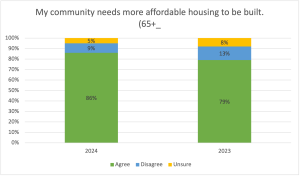
64% of New Hampshire voters think lawmakers should include public investments to build more affordable housing as they contemplate the next budget.
In a new polling question concerning state funding for housing, 64% of respondents agree that as state lawmakers contemplate the next budget, they should include public investments to build more affordable housing. Only 31% disagreed. Again, voters age 65 and older registered the strongest support, with 70% in favor of public funding, and 25% opposed.
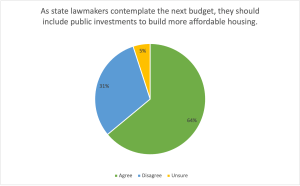
Please email ihpp@anselm.edu for full survey results from 2024 and from previous years. Funding for this survey was provided by New Hampshire Housing.
